Deco Setup Walkthrough (For Deco X20/X60/X90/P9/M4/S4/E4/W2400, etc.)
Deco P9(2-pack) , Deco X60(1-pack) , Deco X20-DSL , Deco E3(3-pack) , Deco E4(3-pack) , Deco X20 , Deco X68 , Deco S4(1-pack) , Deco X25 , Deco E4(1-pack) , Deco S7 , Deco S4 , Deco S4(3-pack) , Deco M4(3-pack) , Deco X60(3-pack) , Deco M4(1-pack) , Deco XE5300 , Deco XE70 Pro , Deco X20(2-pack) , Deco M4 , Deco X90 , Deco XE75 , Deco M3 , Deco W2400 , Deco X50 , Deco X75 , Deco X20(3-pack) , Deco E4(2-pack) , Deco X55 , Deco E4 , Deco E3 , Deco E3(2-pack) , Deco W2400(2-pack) , Deco X20(1-pack) , Deco XE75 Pro , Deco X20-Outdoor , Deco M4(2-pack) , Deco S4(2-pack) , Deco Voice X20 , Deco P9(3-pack) , Deco P9 , Deco X60(2-pack) , Deco X60
Recent updates may have expanded access to feature(s) discussed in this FAQ. Visit your product's support page, select the correct hardware version for your device, and check either the Datasheet or the firmware section for the latest improvements added to your product. Please note that product availability varies by region, and certain models may not be available in your region.
Note: Features available to Deco Mesh Systems may vary by model and software version. All steps and images described here are only examples and may not reflect your actual Deco experience.
Before you begin:
1. To ensure a smooth setup process, please disable the Power-Saving mode on your smartphone.
2. For iOS14 and above, enabling the Local Network feature is REQUIRED to complete the configuration process.
3. Deco Mesh Systems can only be set up via the Deco app, which is available on Android and iOS.
The Deco X60 is used in the example below.
Step 1. Open the Google Play or the App Store to download the Deco app. Install the Deco app on your Android or iOS smartphone or tablet.

Step 2. Open Deco app. Log in or sign up to create a TP-Link ID.
Note: If you already have a TP-Link ID, you can log in with your existing credentials.

Step 3. Tap Let’s begin.

Step 4. Select your Deco model.
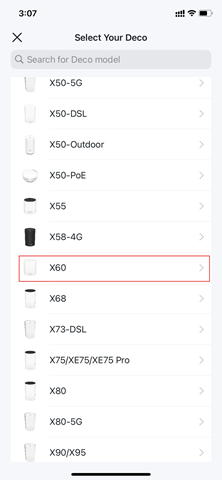
Step 5. Unpack the contents of the box. Once you have verified all its contents are present, move on to the next step.
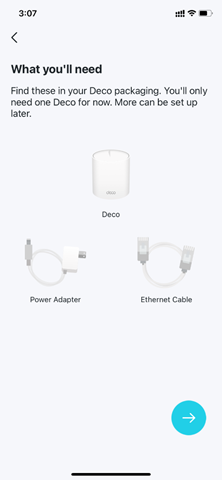
Step 6. Power off your modem and remove the backup battery if it has one.

Step 7. Connect one of your Deco units to your modem using an Ethernet cable and power on both devices.
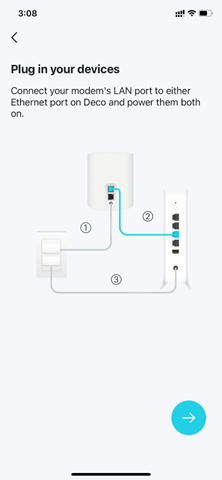
Connect the Ethernet cable between one of your Deco’s WAN/LAN ports and the modem or modem-router as shown in Picture 1 or, to an Ethernet port on the wall (if applicable), as seen like Picture 2.
Picture 1

Picture 2

Step 8. Wait for the ‘Internet’ light on your modem to indicate a stable connection status.

Step 9. Enable Bluetooth on your phone and wait until the Deco’s LED pulses blue.
Note: If the LED is not pulsing blue, press the RESET button on the Deco for one second. The LED will turn yellow. Wait for approximately 2 minutes until the LED changes its status to pulsing blue before proceeding.
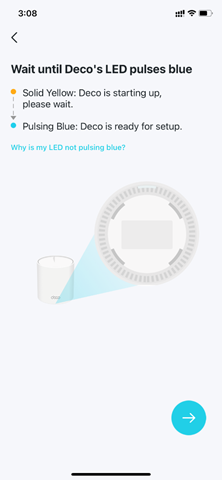
Step 10. Connect your phone to the Deco’s default SSID, which is printed on the bottom label (for example: Deco_XXXX).Note: Some phones may connect to the Deco’s default SSID auto
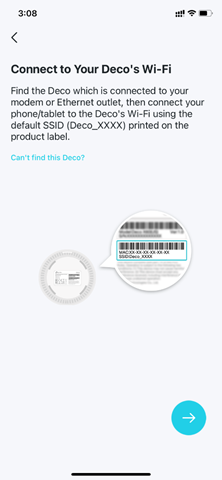
Step 11. Assign your connected Deco to a room. The location will also be used as this Deco’s name.
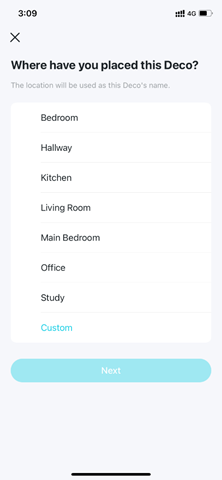
Step 12.. Select your Internet connection type. Common types include PPPoE, Dynamic IP, and Static IP. Select and fill in VLAN ID if required by your ISP (if required, this information should be provided by your ISP). The Common connection types are for reference only.
NOTE: For Connection Type, you can choose Dynamic IP if the Deco wired to a main router/Modem Router, as shown in Picture 1. Alternatively, you may need to confirm with ISP whether your Modem is connected directly to your ISP or a bridge Modem as shown in Picture 2
matically. The Deco app will provide a notification if it finds the Deco.
Picture 1

Picture 2

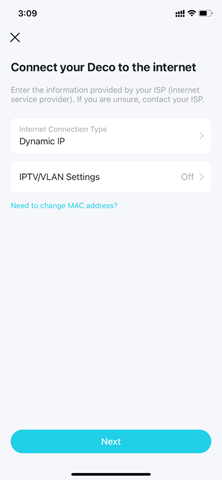
If your ISP requires a VLAN ID, please obtain the VLAN ID from your ISP and enter it using the in-app instructions.
Step 13. Create your Wi-Fi network name and password.
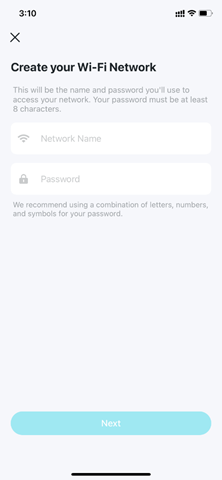
Step 14. Connect your phone or tablet to the Deco’s Wi-Fi network.
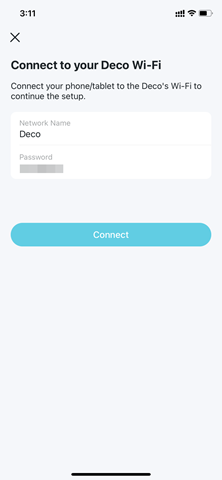
Step 15. Congratulations! Setup is complete. You can now connect all your devices to the Deco Mesh Wi-Fi network.
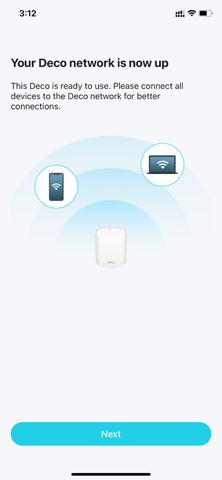
Step 16. If you have other Deco units in the same package, simply plug in these Decos and they will be added to the network within 2 minutes after powering on.
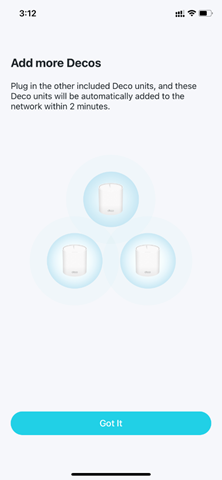
Related FAQs
Is this faq useful?
Your feedback helps improve this site.
What’s your concern with this article?
- Dissatisfied with product
- Too Complicated
- Confusing Title
- Does not apply to me
- Too Vague
- Other
Thank you
We appreciate your feedback.
Click here to contact TP-Link technical support.
TP-Link Community
Still need help? Search for answers, ask questions, and get help from TP-Link experts and other users around the world.
We have updated our Policies. Read Privacy Policy and Terms of Use here.
This website uses cookies to improve website navigation, analyze online activities and have the best possible user experience on our website. You can object to the use of cookies at any time. You can find more information in our privacy policy .
We have updated our Policies. Read Privacy Policy and Terms of Use here.
This website uses cookies to improve website navigation, analyze online activities and have the best possible user experience on our website. You can object to the use of cookies at any time. You can find more information in our privacy policy .
Basic Cookies
These cookies are necessary for the website to function and cannot be deactivated in your systems.
TP-Link
accepted_local_switcher, tp_privacy_base, tp_privacy_marketing, tp_smb-select-product_scence, tp_smb-select-product_scenceSimple, tp_smb-select-product_userChoice, tp_smb-select-product_userChoiceSimple, tp_smb-select-product_userInfo, tp_smb-select-product_userInfoSimple, tp_top-banner, tp_popup-bottom, tp_popup-center, tp_popup-right-middle, tp_popup-right-bottom, tp_productCategoryType
Livechat
__livechat, __lc2_cid, __lc2_cst, __lc_cid, __lc_cst, CASID
Youtube
id, VISITOR_INFO1_LIVE, LOGIN_INFO, SIDCC, SAPISID, APISID, SSID, SID, YSC, __Secure-1PSID, __Secure-1PAPISID, __Secure-1PSIDCC, __Secure-3PSID, __Secure-3PAPISID, __Secure-3PSIDCC, 1P_JAR, AEC, NID, OTZ
Analysis and Marketing Cookies
Analysis cookies enable us to analyze your activities on our website in order to improve and adapt the functionality of our website.
The marketing cookies can be set through our website by our advertising partners in order to create a profile of your interests and to show you relevant advertisements on other websites.
Google Analytics & Google Tag Manager
_gid, _ga_<container-id>, _ga, _gat_gtag_<container-id>
Google Ads & DoubleClick
test_cookie, _gcl_au
Meta Pixel
_fbp
Crazy Egg
cebsp_, _ce.s, _ce.clock_data, _ce.clock_event, cebs
lidc, AnalyticsSyncHistory, UserMatchHistory, bcookie, li_sugr, ln_or


_Overview_normal_20211130005706l.png)